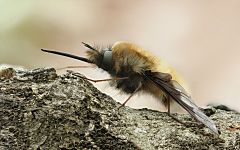Large bee fly facts for kids
Quick facts for kids Large bee fly |
|
|---|---|
 |
|
| Bombylius major | |
| Scientific classification | |
| Kingdom: | |
| Phylum: | |
| Subphylum: | |
| Class: | |
| Subclass: | |
| Infraclass: | |
| Superorder: | |
| Order: | |
| Suborder: |
Brachycera
|
| Family: | |
| Subfamily: |
Bombyliinae
|
| Genus: |
Bombylius
|
| Species: |
B. major
|
| Binomial name | |
| Bombylius major |
|
The Bombylius major, also known as the large bee fly, is a fascinating fly that looks a lot like a bee. This is called mimicry, where one animal copies another to protect itself. The large bee fly is a special kind of insect called a parasitoid. This means its young grow by living on or inside other insects, eventually causing harm to them. In this case, the large bee fly's young feed on the grubs of solitary bees and wasps.
You can usually spot these flies flying around from April to June. They live in many parts of the world, including Europe, North America, and some areas of Asia.
Contents
What Does It Look Like?
The large bee fly is about 1 to 1.5 centimeters (0.4 to 0.6 inches) long. It has a furry, round body that looks like a bumblebee. Its body is covered in thick, yellowish-brown hair. It has long, thin legs and a very long, needle-like mouthpart called a proboscis. This proboscis helps it drink nectar from flowers, just like a hummingbird. Its wings are clear with a dark brown patch near the front edge.
Life Cycle and Reproduction
The life of a large bee fly starts with an egg. The adult female bee fly has a very clever way of laying her eggs. She flies near the underground nests of solitary bees or wasps. These bees and wasps dig tunnels in the ground to lay their own eggs.
When the female bee fly finds a nest entrance, she hovers above it. Then, she quickly flicks her eggs towards the opening. She doesn't go inside the nest herself. The eggs are tiny and covered in dust or sand, which helps them blend in.
Once a bee fly egg hatches, a tiny larva emerges. This larva is very small and active. It must find its way into the bee or wasp nest. Once inside, the bee fly larva looks for the host's grubs. These grubs are the young bees or wasps. The bee fly larva then attaches itself to a host grub. It slowly feeds on the host grub, growing bigger over time. This is how the bee fly acts as a parasitoid.
After feeding enough, the bee fly larva changes into a pupa. This is a resting stage, similar to a butterfly's cocoon. Inside the pupa, the bee fly transforms into an adult. When it's ready, the adult bee fly comes out of the pupa and flies away. It will then find a mate and start the cycle all over again.
Where Do They Live?
Large bee flies are found in many different places around the world. They prefer areas where there are lots of flowers for nectar and where their host bees and wasps live. You can often see them in gardens, meadows, and woodlands. They are common in:
- Most of Europe
- Across North America
- Parts of Asia, including Japan
They are usually seen flying during the spring and early summer months. This is when many flowers are blooming and their host insects are active.
Images for kids
See also
 In Spanish: Mosca abejorro para niños
In Spanish: Mosca abejorro para niños








